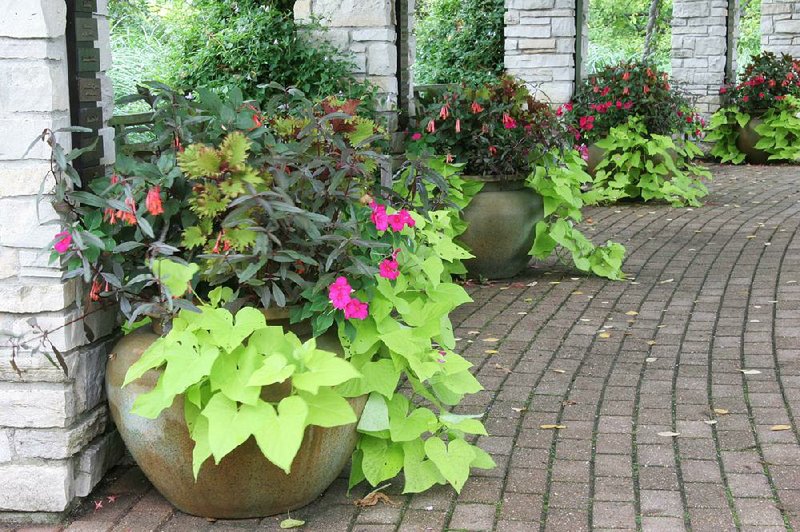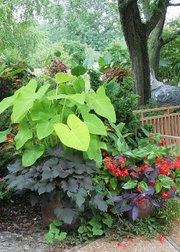No garden is too small or too large for fabulous plantings in flowerpots. Now’s the time to plant them, and it doesn’t take long to get them started.
Pots give gardeners in small spaces room to grow. In large gardens, flowerpots are a great way to develop the detail and grow delicate plants that might otherwise get lost; pots focus the eye just as a frame sharpens the impact of a picture. In gardens of any size, pots are important architectural elements: They might mark an entrance to a garden or march two by two up the front steps. They allow you to bring spots of garden color up onto a porch. Pots are stylish and sculptural, whether their design is avant-garde, traditional or whimsical. No matter what style you favor, they’ll always be fun.
The gardeners at Olbrich Botanical Gardens in Madison, Wis., plant more than 500 flowerpots for the gardening season each year. One collection of a dozen or more pots is an instant burst of inspiration right at the entrance, and other flowerpots can be found in every part of the garden. Jeff Epping, the garden’s horticulture director, teaches a popular class every year on planting flowerpots, helping gardeners put together sparkling plant combinations.
“We try to show artful combinations.
We look at how plants work together, and we work with foliage as well as flowers,” Epping says. “We don’t always have to have what’s brand new - we are looking for new stuff if it fits our designs.”
PLANTING CONFIDENCE
Part of the class focuses on building the confidence of beginning gardeners, who often don’t know quite where to begin. Epping talks about deciding where a pot will go and then filling it with plants that are adapted to that location and have the same requirements for moisture and sun or shade. He advises his classes to pay close attention to foliage because flowers aren’t always blooming, and because the colors and textures of leaves make any combination look more lively.
“Some of our pots don’t have a single flower in them, and I’m fine with that,” he says. “Foliage really is more important in any container than flowers.”
Beyond that, Epping doesn’t adhere to strict formulas. Pick some flowerpots you like and get started, he says. A single large flowerpot makes a strong statement, but “sometimes it’s way more interesting to put pots together in groupings.”
PICKING POTS
Terra-cotta pots are classics, but they dry out more quickly than plastic or glazed pots, Epping says.Big flowerpots have plenty of room for plants’ roots to grow, so they do not need as much attention to watering through the summer as small pots. They also naturally suit the scale of larger plants. Every shape, size and color is represented at Olbrich: There are terra-cotta pots, tabletop pots in a courtyard, big bowl-shaped containers and pots full of roses dotted around the rose garden.
The horticulturists assigned to different areas at Olbrich design the plantings in the pots for their gardens, but they all get together formally to talk about the pots and combinations. Gardeners show slides, discuss their plans and ask their colleagues for help and suggestions. “It’s fun,” Epping says. Ideas for dazzling combinations often emerge from these sessions.
People who attend container classes at Olbrich always want to know what kind of potting soil to buy, and whether they can fill the bottom of large pots with Styrofoam peanuts or crushed aluminum cans to save on potting soil. Epping advises buying top-quality potting soil. Don’t skimp, he says: Fill the pots with potting soil, not with cans. In the course of a summer in the garden, plants’ roots will extend deep into the soil, and good potting soil retains the moisture the plants need.
GO FOR IT
When it comes to planting, don’t limit yourself, Epping says. “I get tired of the same old annuals, annuals, annuals,” he says. Gardeners at Olbrich plant all sorts of small trees and shrubs in pots - half-moon maples, smoke bush, evergreen boxwoods, yews and gold-mop false cypress.
“We’re using a lot of bolder tropical things, too,” Epping says. Big elephant’s ears and bananas are dramatic, stately and luxurious. In the rose garden, flowerpots are planted with romantic pink, blue and purple flowers.
Elsewhere, in the perennial garden area, orange, red and yellow blooms predominate. The pots in the herb garden are naturally full of herbs, but the gardeners also spice up the combinations with bright edible flowers such as calendulas and nasturtiums, as well as with kale, lettuce and even okra plants.
“We don’t rely on one group or a single plant,” Epping says. “It’s always a little of this and a little of that.” Let the selection of plants at a garden shop inspire you - you can start putting together intriguing combinations right in your shopping cart. “There is so much stuff out there,” Epping says. “It’s time to get growing.”
HomeStyle, Pages 35 on 05/25/2013


